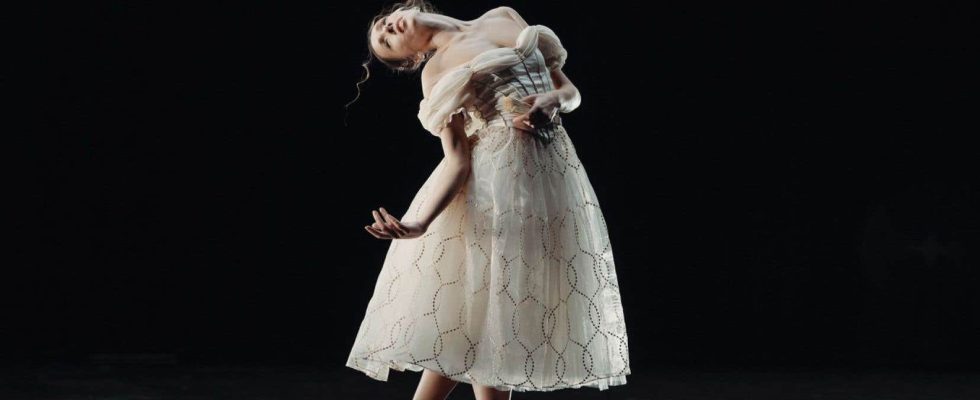Last night was the premiere of the play The Lady of the Camellias, classic novel of French literature by Alexandre Dumas fils. It is by drawing on the essence of the work that the choreographer Peter Quanz has deployed the four scenes of the work: Love, The Sacrifice, The Abyss and The Death. A whirlwind journey of emotions, supported by the technical mastery of the artists and a precise and sought-after scenography.
Enter a universe, even before the show begins. This is because we succeed in making the Grands Ballets with a simple little gesture: offering the spectators a handwritten letter in an envelope as a program, the Grands Ballets already transport us to another era and plunges us into Paris, in the 19th century. The first moments then reveal the characters to us: three couples play the mythical couple of the work, the courtesan Marguerite Gautier and her lover Armand Duval. A choice which notably allows us to see the color of each performer and to make them embody each phase of this tragic epic in a more precise and in-depth way.
As usual, the artists of the Grands Ballets reveal in this piece a great mastery of their art. Pirouettes, carousels, grand jets, arabesques… the vocabulary of classical ballet is used throughout the work and always delights us. The lines are there to delight lovers of the classic. Several pas-de-deux extend through the work, sometimes with some length, but demonstrate the beautiful chemistry of the three couples. The lifts are majestic, the pirouettes are romantic, the beautiful dresses of the dancers twirl to the sound of love, the bodies separating to get closer together, in warm and loving breaths. That’s nice to look at.
On the gesture side, although we remain in classical and neo-classical ballet and their codes, Peter Quanz allowed himself some curves, breaks and some passages on the ground, in particular with the darker group, the choir of dancers who support the narration and serve as a sort of transition into the pulpit of history. In this mass, where neither men nor women are identified (which is rather rare in the world of ballet), the gestures seem sprinkled with contemporary movements. The arches are more radical, the undulations and the releases more marked.
Appearing light at first, the story of The Lady of the Camellias quickly becomes tinged with darkness and violence. After the romanticism and love exacerbated by the first duo, aggression and constraints take place in the lives of the courtesans. While remaining in the lightness of the movements, the choreographer sprinkles symbols, voluntary contractions, a lack of fluidity, to convey the uneasiness that is playing out before the spectator’s eyes. The end of the first act surprises us and chills us. The table is then set for what follows…
Dance with a taste of the 7th art
Throughout the show, the scenography is well thought out, very elaborate and pleasing to the eye. From the beautiful colorful dresses to the men’s costumes, including the floral suspension, the candlesticks, the furniture or the curtains, the sets embrace and water the bodies of the performers, almost becoming a scene from a film. In addition to beautifying the scene, the decorative elements serve the story and create scenes of everyday life. They are sometimes even used to create movement and understand certain relationships between the different protagonists. The scene after the curtain rises in the second act is also quite spectacular.
In addition, the music, often epic, does not clash with the cinematographic aspect. On the contrary, it accompanies and guides the different emotions that play out between the characters, but also what the audience feels. Full of nuances, the Orchester des Grands Ballets transports us.
Decor and music establish a whole which allows the piece to become a quasi-work of cinema. Indeed, in certain scenes, several key moments take place at the same time before our eyes, thus recreating different places, or featuring several subgroups. Although the interpreters do not use speech, parallel situations can be detected. So reminiscent of cinema or theater. Finally, the narrator, who intervenes a few times, also adds to the story, allowing both to follow and to add this cinematographic / theatrical aspect. Enough to accompany the spectator, and to be certain that he grasps all the tragedy of this story.
Because, in fact, it is a drama that is playing out before our eyes. After experiencing a forbidden but unconditional love, the beautiful Marguerite, sick, passes away. The final scene, done with great delicacy, then leaves room for more simplicity and more authenticity too. Soft, silky and floating decorative elements then evoke death, without brutality. On the contrary, with a lot of poetry. The papers falling from the sky, like news that we often don’t want to read, multiply and unwittingly become a narrative in themselves. Beautiful images are then created and vibrate, in harmony with the music, releasing all the sensitivity and vulnerability necessary to finish this piece.
Although The Lady of the Camellias remains a classic work, with these codes, particularly gestural, it displays some more contemporary originalities and ends with a delicate opening which leaves a beautiful image in our hearts.
The Great Ballets The Lady of the Camellias take place from October 19 to 28 at the Wilfrid-Pelletier Hall.
